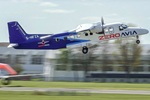ZeroAvia is awarded U.S. Air Force grant for autonomous hydrogen-electric aircraft
ZeroAvia will analyze the potential for developing and delivering an autonomous aircraft with hydrogen-electric propulsion for reduced engine noise and low thermal signature.
Source | ZeroAvia
(Everett, Wash., U.S.) has been selected by AFWERX for a Small Business Innovation Research (SBIR) grant to conduct a feasibility study focused on integrating hydrogen propulsion into Cessna Caravan aircraft alongside advanced aircraft automation technology. AFWERX awards aim to address research questions with specific implications for the most pressing challenges in the Department of the Air Force (DAF).
ZeroAvia will analyze the potential for developing and delivering an 8,000-pound autonomous aircraft with hydrogen-electric propulsion for reduced engine noise and low thermal signature to reduce detectability. According to the company, hydrogen fuel cells are a promising technology for improving the range, duration and turnaround time of a range of electric unmanned aerial vehicles (UAV).
Hydrogen has additional advantages as an aviation fuel as it can be produced at point of refueling given ready supply of electricity and water, which dramatically simplifies fuel logistics — a critical consideration for any defense applications. Finally, hydrogen has the highest energy per unit of weight of any chemical energy source, which enables potential maximum range of more than 2,000 nautical miles (almost 4,000 kilometers) in an autonomous aircraft of this type.
Reliable Robotics (Mountain View, Calif., U.S.), specialists in remote operation of aircraft, will support ZeroAvia in exploring relevant autonomous flight systems as part of the study.
The DAF began offering the Open Topic SBIR/STTR program in 2018 which expanded the range of innovations the DAF funded. ZeroAvia has started its own journey to create and provide innovative capabilities. The company is currently advancing certification of a 600-kilowatt hydrogen-electric powertrain — ZA600, which uses fuel cells to convert hydrogen fuel into electricity to power electric motors — with civil regulators. The planned first airframe is the Cessna Caravan, manufactured by Textron (Wichita, Kan., U.S.). The company recently announced a significant regulatory milestone after receiving an FAA G-1 issue paper for the 600-kilowatt electric propulsion system.
“This feasibility study will provide greater insight into how hydrogen fuel cell propulsion can reduce detectability and costs of air operations, enhance capability of autonomous air vehicles and de-risk fuel supply in forward operating environments,” says Val Miftakhov, founder and CEO of ZeroAvia.
The views expressed are those of the author and do not necessarily reflect the official policy or position of the Department of the Air Force, the Department of Defense or the U.S. government.
Related Content
-
Airbus outlines next-gen single-aisle aircraft technology focuses, revised ZEROe project roadmap
Outlined technology bricks — including foldable wings, more efficient engines and propulsion and composite materials — could support a planned single-aisle next decade, plus Airbus’s renewed commitment of a commercially viable H2 aircraft.
-
Update: THOR project for industrialized, recyclable thermoplastic composite tanks for hydrogen storage
A look into the tape/liner materials, LATW/recycling processes, design software and new equipment toward commercialization of Type 4.5 tanks.
-
Composite bipolar plates provide 81% improvement to hydrogen fuel cell power density
Ultra-thin CFRTP plates developed by Hycco achieve a 7.5 kilowatt/kilogram power density, high durability for fuel cells in long-flight drone and heavy-mobility applications.






